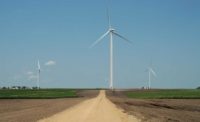The windswept fields and gusty greens of Ireland’s County Mayo are perfect places for a kite or a glider, or, in the case of energy partners E.ON and Ampyx Power, a large flying wing tethered to a drum, which will drive an experimental, portable power-generating turbine.
While the notion seems a far-out concept, E.ON and Ampyx are setting up a €3-million test field near the rugged western Irish coast to build out airborne wind energy technologies. E.ON is a large German utility company. Ampyx is a startup Dutch engineering firm with a third-generation prototype on its hands.
Ampyx and other emerging power technologies were some of the voices heard in Berlin in mid-April at the IDTechEx Show!, with a spotlight on fields from off-grid energy to energy harvesting, storage and even printed electronics and graphene.
Ampyx Power is now producing a near full-scale prototype of its twin-hulled fiberglass-and-carbon flyer that has a 12-meter wingspan, weighs 350 kilograms and is able to generate 250 kW of power. Founder Richard Ruiterkamp explains that the energy flyer works almost as if it were an airborne water-skier flying at 450 m. It picks up speed and creates tension on its thin polyethylene tether by traveling in a sweeping, side-to-side pattern. The tether is wrapped over a drum, which acts as a flywheel as the tether spools in and out in response to the moving flyer, which in turn powers a turbine. A winch underneath keeps the spooling orderly in and out over the drum.
That is the basic concept behind airborne energy systems, although the flyers taking shape in the shop vary widely, as do several of the design, control and sensing elements.
Ampyx’s machine takes off at the behest of meteorological inputs, with the aim to be fully automated and launched by catapult. It climbs with a small onboard propulsion system. TwingTec, a Swiss startup funded in part by the European Space Agency and a spinoff of the Swiss Federal Laboratories for Materials Science and Technology, instead employs a drone copter-like approach to lifting its version of an energy-producing wing straight up into the air. Plans call for a 10kW pilot system later this year, with a production model 100kW to follow, with the generator assembly stored in portable shipping containers for mobile use.
While fixed wings are a large part of the field, oversized pinwheeling soft-fabric kites are also in the mix, with Italian-German partnership Rotokite set to spin off from Sequoia It.
Turning to the sea, Plymouth, England-based Witt Ltd. has developed a prototype pendulum-driven, energy-generating system that sets itself in the middle of any degree of motion inside a sealed unit. The system’s two pendulums connect to a flywheel. Looking something like a cross between a gimbal, an oversized hamster wheel and an astronaut trainer, the idea is that the WITT—Whatever Input to Torsion Transfer—“harvests” motion from any direction. The turning flywheel powers the energy generator. Initial applications are for powering buoys or other low-power undersea objects, with a marine WITT set for product launch this year.
Related Article: How Engineers Help Navigate Renewables and Distributed Generation



Post a comment to this article
Report Abusive Comment